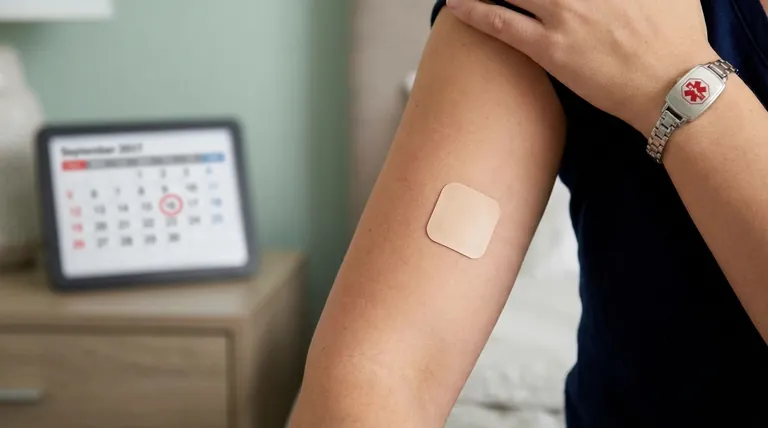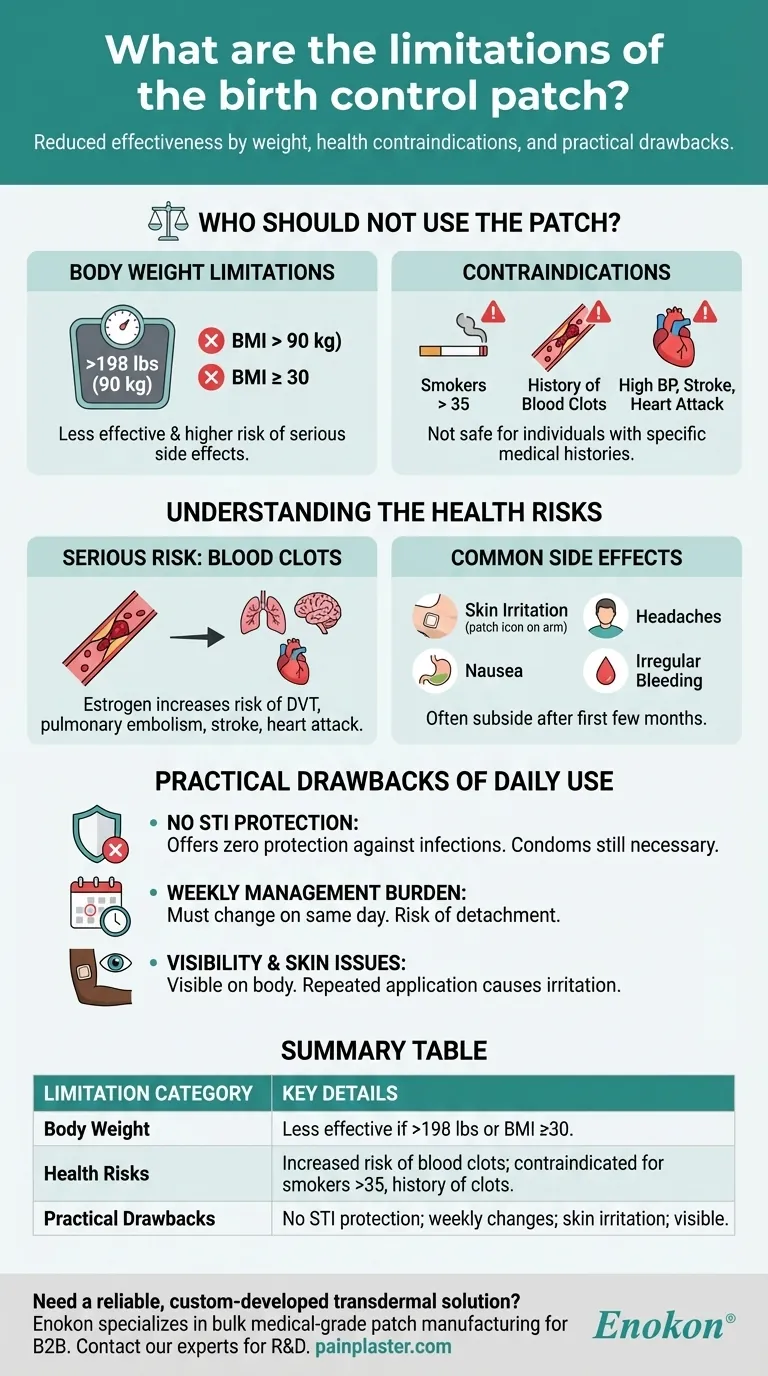The primary limitations of the birth control patch are its reduced effectiveness in women over a certain body weight, a list of significant health contraindications, and several practical drawbacks. It exposes users to higher levels of estrogen than many combination pills, which increases the risk of serious side effects like blood clots for individuals with specific health profiles.
The birth control patch is not a universally suitable option. Its effectiveness is dependent on body weight, its safety is contingent on your medical history, and its convenience is offset by the need for weekly diligence and its lack of STI protection.

Who Should Not Use the Patch?
The patch is a hormonal contraceptive, and its use of synthetic estrogen and progestin means it is not a safe or effective choice for everyone. Certain physical attributes and pre-existing health conditions can make using the patch dangerous.
Limitations Based on Body Weight
The patch may be less effective at preventing pregnancy in women who weigh more than 198 pounds (90 kg).
Furthermore, it is not recommended for women with a Body Mass Index (BMI) of 30 or greater, as the risk of serious side effects, particularly blood clots, increases significantly.
Contraindications for Pre-existing Conditions
The patch should not be used by individuals with a history of certain medical issues.
This includes women who smoke and are over 35, have a history of blood clots, high blood pressure, heart attack, or stroke. It is also contraindicated for those with breast or uterine cancer, uncontrolled diabetes, liver disease, or unexplained vaginal bleeding.
Understanding the Health Risks
While effective for many, the hormonal delivery method of the patch carries specific risks ranging from common side effects to rare but life-threatening complications.
The Most Serious Risk: Blood Clots
The use of estrogen-containing birth control slightly increases the risk of developing serious blood clots.
These clots can lead to a deep vein thrombosis (DVT), pulmonary embolism, stroke, or heart attack, which can cause permanent disability or death. This risk is highest when first starting the patch or when restarting it after a break of a month or more.
Common Side Effects
Many users experience side effects, though they often subside after the first few months.
These can include skin irritation at the application site, headaches, breast tenderness, nausea, and irregular bleeding or spotting. Other potential side effects are mood changes, bloating, and moderate weight gain.
The Practical Drawbacks of Daily Use
Beyond the medical considerations, the patch has several practical limitations that can affect a user's experience and overall protection.
No Protection Against STIs
This is a critical limitation. The birth control patch offers zero protection against sexually transmitted infections (STIs), including HIV. Barrier methods like condoms are still necessary for STI prevention.
The Management Burden
The patch's effectiveness relies on perfect use. You must remember to change it on the same day each week. Forgetting to change it on time can reduce its effectiveness and increase the risk of pregnancy.
There is also a risk that the patch could become loose or fall off completely, requiring immediate action to maintain contraceptive protection.
Visibility and Skin Issues
The patch is visible on the body, which may be a concern for some users. It can be more noticeable on darker skin tones.
Additionally, applying the patch to the same spot repeatedly can lead to persistent skin irritation.
Making an Informed Decision
Understanding these limitations is key to determining if the patch aligns with your health profile and lifestyle.
- If your primary focus is maximum effectiveness: You must confirm that your body weight is under 198 pounds and your BMI is below 30.
- If you have pre-existing health conditions: You must have a thorough discussion with your doctor about your medical history, especially regarding smoking, blood pressure, or any history of blood clots.
- If your priority is convenience and STI protection: You need to weigh the weekly change schedule and potential for detachment against other methods and remember that you still need condoms for STI prevention.
Ultimately, choosing the right birth control is a personal decision that should be made with a clear understanding of the risks and benefits in consultation with your healthcare provider.
Summary Table:
| Limitation Category | Key Details |
|---|---|
| Body Weight | Less effective if >198 lbs (90 kg) or BMI ≥30. |
| Health Risks | Increased risk of blood clots; contraindicated for smokers over 35, history of clots, stroke, etc. |
| Practical Drawbacks | No STI protection; requires weekly changes; can cause skin irritation; visible on skin. |
Need a reliable, custom-developed transdermal solution?
As a bulk manufacturer of medical-grade transdermal patches, Enokon specializes in creating safe and effective solutions for healthcare and pharmaceutical brands. If you are developing a hormone delivery system or any other transdermal product, benefit from our technical expertise for custom R&D and development.
Contact our experts today to discuss your project requirements.
Visual Guide

Related Products
- Prostate Pain Kidney Health Care Patch for Men
- Menthol Gel Pain Relief Patch
- Capsaicin Chili Medicated Pain Relief Patches
- Lidocaine Hydrogel Pain Relief Patch for Pain Relief
- Far Infrared Deep Heat Relief Patches Medicated Pain Relief Patches
People Also Ask
- What should be done before undergoing an MRI while using testosterone patches? Remove it to prevent serious burns.
- What precautions should be taken when applying testosterone patches? Maximize Safety and Effectiveness
- How often should testosterone patches be applied? Daily Dosage & Best Practices
- What lifestyle factors should be considered when choosing between testosterone patches and injections? Find Your Best Fit
- What is the purpose of testosterone patches? A Steady Solution for Low Testosterone















